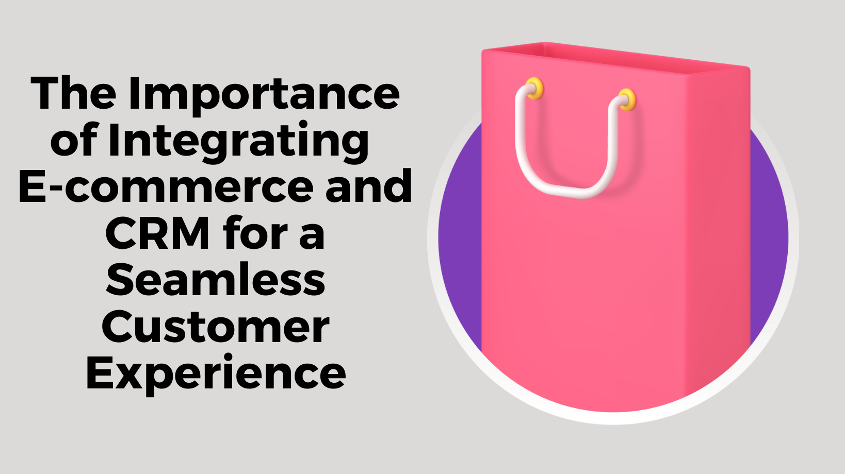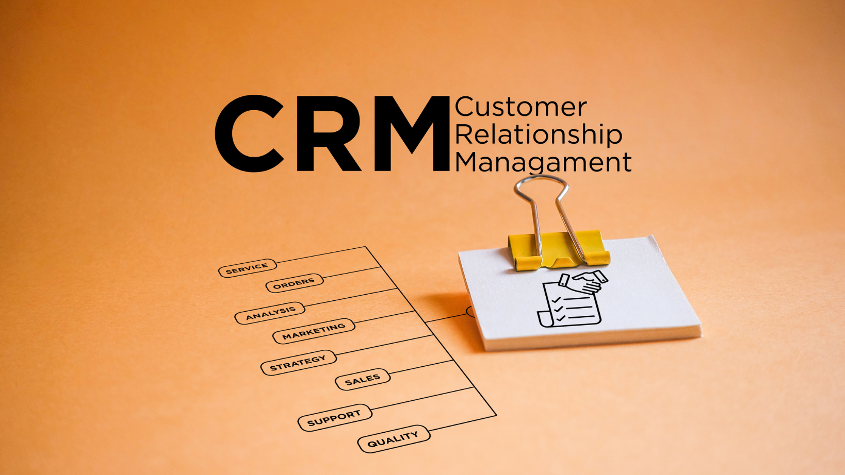
Keeping up with customers' shifting needs and demands is essential for success in today's fast-paced digital market. The success of this trend depends on integrating customer relationships and e-commerce platforms.
CRM systems help companies keep track of their customers across all channels, but e-commerce platforms help them sell products and services online. By combining these systems, businesses can gain a lot.
In order to stay competitive and provide the best customer experience, businesses must integrate their e-commerce and CRM solutions.
Benefits of Integrating E-commerce and CRM
1. Better Sales Performance
The integration provides targeted marketing, upselling, cross-selling, and rapid order processing opportunities. Businesses can customize their marketing campaigns using a unified customer view to target more likely customers. This increases revenue and conversions.
Integration facilitates promotion and cross-selling. Businesses can suggest analogous items or upgrades to customers using customer data such as purchase history and preferences. This enhances the customer experience and increases the average order value.
Effective order management increases sales. Integration facilitates order fulfillment, eliminating errors and delays. Faster delivery and greater customer satisfaction can increase customer retention and referrals.
2. Improved Customer Experience
The development of the CRM market has been significantly propelled by companies' investments in personalization technologies. By leveraging these advanced tools, businesses have been able to enhance their customer relationships and deliver tailored experiences.
Furthermore, the integration of e-commerce and a simple CRM systems, as an alternative to Salesforce, has played a pivotal role in streamlining operations and gaining a deeper understanding of customers.
This integration has allowed businesses to track customer behavior, preferences, and purchase history, enabling them to personalize marketing campaigns and offer targeted product recommendations.
While implementing CRM solutions presents challenges, the overall impact has been positive. Companies have been able to optimize their customer interactions, increase customer satisfaction, and ultimately drive revenue growth through more effective sales and marketing strategies.
Businesses can track consumer activity from web browsing to in-store purchases with a unified customer view. Marketing campaigns can be customized, targeted promotions offered, and suggestions tailored to customers.
Brand loyalty increases with consistent experiences across all consumer touchpoints. Customers who feel valued are more likely to return and recommend a business.
To remain competitive in the CRM market, businesses must adopt new technologies and methodologies. By integrating CRM solutions with e-commerce platforms, businesses can boost customer confidence, loyalty, and development.
3. Enhanced Analytics and Reporting
Companies can obtain insights into customer behavior by collecting and analyzing more accurate and complete customer data. Marketers and salespeople can use these findings to optimize prices and enhance products.
Data analytics and reporting enable businesses to make better decisions. Product pricing, marketing, and stocking can be targeted more precisely. Utilizing these options can increase profits, customer satisfaction, and productivity.
Moreover, performance data can also be used to identify patterns and identify growth prospects based on the data. Businesses can make better decisions by understanding consumers.
Key Features of an Integrated E-commerce and CRM System
1. Seamless Data Synchronization
The integration of e-commerce and CRM requires seamless data synchronization. It maintains accurate, current, and consistent consumer data across all interfaces. Customers have access to the same information regardless of the touchpoint. The CRM solutions must account for a customer's new Internet address and vice versa. By seamlessly synchronizing consumer data, businesses can enhance customer experience, targeted marketing, and order fulfillment. Companies risk confusion, frustration, and sales loss if data is not synchronized.
2. Automated Processes
Integrating e-commerce with customer relationship management systems can also achieve a smooth operation. Automated data entry, order processing, and marketing campaigns save time and reduce errors. This can boost efficiency, cost, and customer satisfaction.
Automated order processing can swiftly and precisely fulfill orders, accelerating delivery and pleasing customers. Automated marketing initiatives save time and money while delivering timely, personalized customer communication. Automation allows businesses to expand without adding personnel. Automated processes assist businesses in working smarter, not harder, enhancing their productivity and profitability.
3. Comprehensive Reporting and Analytics
In order to integrate E-commerce and CRM effectively, detailed reporting and analytics are required. Businesses can gain insight into consumer behavior, sales performance, and other metrics by evaluating data from various sources. These insights can aid in improving pricing, marketing, and sales strategies.
Analytics can assist businesses in identifying popular products and adjusting pricing and marketing. Analytics can help them identify consumer behavior patterns and develop targeted marketing campaigns to acquire new customers or upsell existing ones. Comprehensive reporting and analytics enable businesses to make data-driven decisions and maintain a competitive advantage.
Best Practices for Successful Integration

1. Conduct a Needs Assessment
When integrating e-commerce and CRM, make sure it is compatible by analyzing the requirements. This involves analyzing the business, identifying pain points and development opportunities, and determining what features and functions are required to achieve business objectives. IT, marketing, and customer service professionals must participate.
A requirements analysis helps businesses identify and implement the appropriate e-commerce and CRM solutions. This prevents costly errors and ensures successful integration. Needs assessments can also be used to identify risks and develop mitigation strategies. Assessments of needs are crucial to successful integration that yields business results.
2. Choose the Right Technology Solution
This involves analyzing the business, identifying pain points and development opportunities, and determining what features and functions are required to achieve business objectives. IT, marketing, and customer service professionals must participate.
A requirements analysis assists businesses in identifying and implementing the appropriate e-commerce and CRM solutions. This prevents costly errors and ensures successful integration. Needs assessments can also be used to identify risks and develop mitigation strategies.
3. Develop a Comprehensive Implementation Plan
Integration of e-commerce and CRM requires a comprehensive implementation strategy. This strategy must include dates, milestones, and deliverables for each integration phase. It should also include a plan for communicating with stakeholders throughout the duration of the endeavor.
Additionally, the strategy should identify and assign personnel, equipment, and software. The plan should also include a comprehensive testing strategy to ensure the integration functions as expected and to identify and resolve any issues before they affect consumers. A comprehensive implementation plan can help complete the integration on time, within budget, and with minimal business disruption. It can also identify risks and create a strategy for success.
4. Provide Training and Support
The success of E-commerce and CRM integration is contingent upon training and assistance. This includes training employees on the new systems and assisting them with any questions or issues. IT, marketing, and customer service employees must be included to ensure they understand and can use the new technologies to achieve company objectives.
After integration, continuous support can aid in resolving issues and maintaining system functionality. Comprehensive training and support can help employees feel confident using the new systems, facilitating the transition and increasing acceptance rates. Training and support are essential for successfully integrating e-commerce and CRM and achieving commercial results.
5. Continuously Monitor and Evaluate Performance
E-commerce and CRM application integration is only effective if constantly tracked and analyzed. Data collection and analysis are essential for boosting revenue, customer interest, and website visits. Businesses may improve customer satisfaction and income through regular performance monitoring and data-driven decision-making.
Opportunities for growth, such as additional distribution channels or product lines, might also be uncovered through performance monitoring. Monitoring and reviewing e-commerce and CRM systems to fulfill customer and company needs can help businesses stay ahead of the competition.
Conclusion
To create a seamless consumer experience and remain competitive, businesses must integrate e-commerce and CRM platforms. Businesses must take a strategic approach to integration, beginning with a requirements assessment, designing a comprehensive implementation plan, offering training and assistance, and monitoring and evaluating performance.
Following these processes and integrating e-commerce and CRM can enhance the customer experience, sales, and development. Integrating e-commerce and CRM applications will remain critical to any successful business strategy as the business landscape evolves.
FAQs
1. What role do training and support play in e-commerce and CRM integration?
Training and support are essential to incorporating e-commerce and CRM because they enable employees to comprehend and effectively use the new systems, resulting in a smoother transition and higher adoption rates.
2. How often should businesses monitor and evaluate performance after e-commerce and CRM integration?
After integrating e-commerce and CRM, businesses should continuously monitor and evaluate performance to identify improvement and optimization areas and ensure that the systems continue to meet evolving business and customer requirements.
3. What are typical obstacles businesses may face when integrating e-commerce and CRM systems?
When integrating e-commerce and CRM systems, businesses frequently encounter several obstacles, the most common of which are technical concerns, data synchronization issues, and employee resistance. However, businesses can surmount these obstacles and achieve success if they employ industry best practices and seek the assistance of experienced professionals.
Share this post
Leave a comment
All comments are moderated. Spammy and bot submitted comments are deleted. Please submit the comments that are helpful to others, and we'll approve your comments. A comment that includes outbound link will only be approved if the content is relevant to the topic, and has some value to our readers.

Comments (0)
No comment